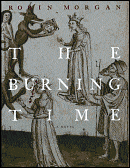
This novel opens on a dark and stormy night—Samhain, 1324—with the bishop’s army out terrorizing the peasants. The soldiers have an encounter:
But with the next stab of lightning, the commander started in terror, as did his men, many of them dropping their weapons, falling to their knees, and crossing themselves.
The flash imprinted on their gaze a sight they would never be able to forget. The lightening had exposed, like a reflection, the head of the Rider. It glowed in the light, inhumanly large. It was crowned by two sharp, bright, upcurving horns.
“Merry Meet, this Samhain Sabbat,” It roared. “You need search for Me no longer. You have met the One you seek” (pp. 15-16).
Turn the page, and in a flashback we meet the bishop and his aide. Corpulent Bishop Ledrede, lover of luxury, is seasick and afraid to “lean vomitously” again over the side of the ship bringing him back to Ireland. He has just come from Avignon and the papal court of John XXII with orders to bring order to Ireland. He thinks and speaks like Gordon Gecko twinned with Jerry Falwell. His aide, Father Brendan, who speaks a phony Barry Fitzgerald Irish brogue from 1940s movies, tries to persuade the bishop to go easy on the Irish and gives a brief history of Celtic Ireland that probably wasn’t known in 1324. In Chapter 2, we meet Dame Alyce Kyteler, the heroine of our story and a desperate if learned housewife, who is enjoying sleeping alone and contemplating the joys of having windows in the castle. She’s joined in her bed by Prickeare, “whose charcoal grey coat was so densely plush it appeared sable black in most light.” Dame Alyce’s thoughts turn to her preparations for Lammas. She has forgotten to bake crescent cakes from “a thousand-year-old recipe.” (Did the Celts in Ireland in 300 CE use recipes when they cooked?) While Alyce is out midwifing a baby, the bishop arrives for a pastoral visit. After he has waited all morning, she finally returns, bloody, worn out, and annoyed. He lectures Alyce on the proper place of woman, Alyce lectures him on feminist independence and the Old Ways—she is the High Priestess of the local coven, as if medieval Celts had covens—and the fuse of the plot is ignited.
There are historical records of the persecution and trial of Alyce Kyteler that Morgan cites in her Author’s Note. But historicity seems not to be the point of this novel. The characters are thoroughly modern. The bishops is more interested in politics (his own advancement) than anything else, and Alyce’s peasants act like modern Wiccans we’ve all met and talk like stage Irish with “dinnas” and “cannas” that make the reader wanna puke. The lecture Alyce delivers to the bishop could be straight out of The Great Cosmic Mother and maybe The Spiral Dance. Yes, the Church did persecute unbelievers; yes, there was a lot of psychological projection on both sides of the conflict; yes, people were burned throughout Europe; yes, the number arrested and executed may be closer to 60,000 than nine million. Yes, Alyce was one of the few who got away.
Robin Morgan is a highly-respected journalist and one of the founders of the second wave American feminism in the 1970s. Her anthologies, Sisterhood Is Powerful, Sisterhood Is Global, and Sisterhood Is Forever, inspired a whole generation of women. If she had written this novel twenty-five years ago, we would adore it and believe every word, for back then we were still inventing our medieval roots and learning our craft. (Our Craft.) Today we are marginally more sophisticated. We more or less recognize our foundational myths now and know a bit more about real history than we used to. Morgan’s Sisterhood anthologies are ten times better than this novel. Read them instead. More than ever before, women need to know that sisterhood really is powerful.
~review by Barbara Ardinger, Ph.D.
Author: Robin Morgan
Melville House Publishing, 2006
